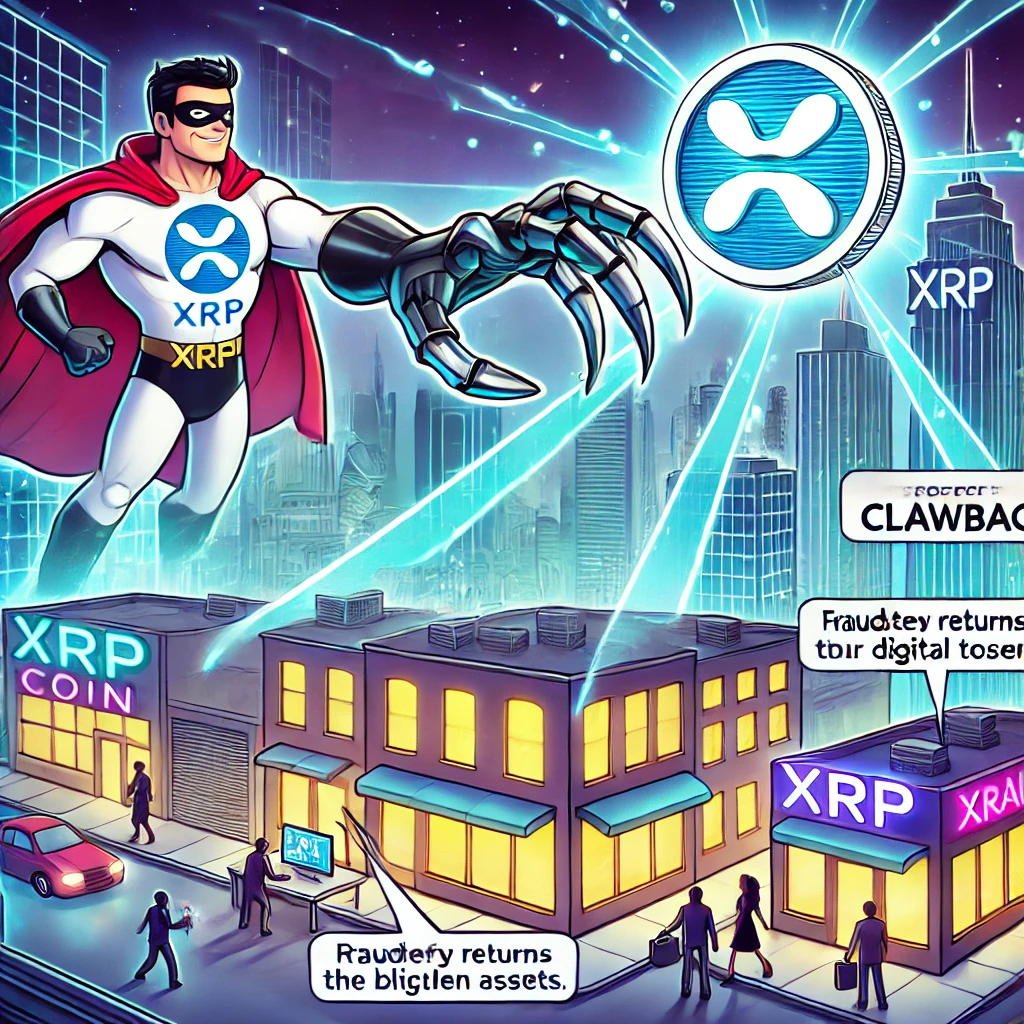By Qamar Zaman | Coffee With Q News
9-Second Elevator Pitch: “XRP Ledger just got an update—claw back. Some call it necessary for compliance, others say it chips away at decentralization. But is it a game-changer or a red flag for blockchain purists? Let’s break it down over coffee!”
As I took my first sip of coffee, I scrolled through the latest crypto headlines and saw something that made me pause.
XRP Ledger (XRPL) has introduced a new clawback feature, sparking heated debates across the blockchain world. On the one hand, it could attract traditional finance and regulatory approval, making XRP more appealing to institutions. On the other hand, does this step inch XRP closer to centralized control? Let’s brew through the details.
What Exactly is the Clawback Feature?
The clawback feature—officially introduced via the AMMClawback amendment—allows token issuers on the XRP Ledger to reclaim tokens under specific circumstances. The reasons could include fraud prevention, errors in token distribution, or regulatory compliance.
🔹 Key Points to Know:
✔ Not Automatic – Issuers must enable it through an “AccountSet” transaction.
✔ Does NOT Apply to XRP – This feature is only for issued tokens, not XRP itself.
✔ Regulatory Alignment – Makes XRPL more attractive to financial institutions by allowing compliance-friendly controls.
Why Does This Matter? A Look at Regulation & Big Money Moves
One of the biggest hurdles for mainstream crypto adoption has always been regulatory uncertainty. Governments and institutions want more control mechanisms in place before fully embracing blockchain technology.
This clawback feature could help XRP Ledger:
📌 Attract Institutional Players – Traditional finance wants accountability in digital assets. This brings more trust to the platform.
📌 Increase Regulatory Compliance – Issuers can now revoke tokens tied to illicit activity.
📌 Make XRPL More Appealing for Stablecoins & CBDCs – Think of Ripple USD (RLUSD) and the broader stablecoin ecosystem.
💬 Ripple CTO David Schwartz explains:
“This feature doesn’t affect XRP itself, but it does give issued tokens on XRPL a more compliance-friendly edge, which could be beneficial for banks and financial institutions.”
MasterCard + Ripple: A New Era of Financial Integration?
And just when you thought XRP Ledger was done making headlines, MasterCard recently announced its partnership with Ripple to explore central bank digital currencies (CBDCs).
This is HUGE because:
✔ MasterCard is one of the biggest global payment networks
✔ Ripple’s blockchain expertise could modernize cross-border transactions
✔ The move aligns with regulators’ push for compliance-based digital assets
🔍 Could XRP’s Clawback Feature be Part of This?
Possibly. If traditional banks & institutions start issuing stablecoins or tokenized assets on XRPL, having a safety mechanism like clawback might make them more comfortable with the technology.
But… Does This Mean XRP is Becoming Less Decentralized?
This is where crypto purists start raising eyebrows. Is the clawback feature a slippery slope toward centralized control? Let’s break it down.
🚀 Why It’s Still Decentralized:
✔ The feature ONLY applies to issued tokens, NOT XRP transactions.
✔ XRPL remains governed by a supermajority vote from validators—no single entity can control it.
✔ Users can choose whether or not to interact with clawback-enabled tokens.
⚠ Why Critics Are Concerned:
🚨 If issuers can reclaim tokens, does this give them too much control over assets?
🚨 The feature allows reversibility, which goes against blockchain immutability.
🚨 Some fear this could set a precedent for more issuer-led control in the future.
💬 Crypto investor Raoul Pal commented:
“Regulatory clarity is great, but we should be careful not to lose the essence of why blockchain exists in the first place—decentralization.”
How This Compares to Traditional Finance: A Bridge Between Two Worlds?
To understand why this feature matters, let’s compare it to traditional finance tools:
✔ Credit Card Chargebacks – Customers can reverse transactions in case of fraud.
✔ Bank Wire Recalls – Banks can retrieve funds in certain disputed cases.
✔ Stock Market Freezes – Regulatory bodies can halt trades or reverse errors.
By adding a clawback feature, XRP Ledger is bridging the gap between blockchain technology and real-world financial safeguards.
What Can Small Investors Learn from This?
At Coffee With Q, we love breaking things down for everyday investors. So, what does this mean if you’re holding XRP or trading on the XRPL?
☕ If You Believe in Institutional Adoption – This feature might make XRP Ledger more mainstream-friendly, leading to more institutional money flowing in.
☕ If You Value Full Decentralization – You might be wary of a feature that allows issuers to “take back” tokens.
☕ If You’re a Small Investor – ETFs (like the proposed XRP ETF) allow you to invest in XRP’s future without dealing with wallet security or transaction reversibility.
💡 Example: Look at the success of Grayscale’s Ethereum Trust ETF (ETHE). It allowed small investors to get Ethereum exposure without managing wallets. Similarly, if an XRP ETF is approved, retail investors might prefer a regulated way to invest.
Final Sip: What’s the Verdict?
☕ For Big Institutions → Good move. Regulatory clarity means more trust, more adoption.
☕ For Decentralization Purists → Mixed feelings. While XRP itself isn’t affected, some worry about creeping centralization.
☕ For Retail Investors → ETFs & compliance-friendly crypto products could make digital assets more accessible and less risky.
💬 Crypto entrepreneur Anthony Pompliano puts it best:
“The future of finance isn’t black and white. It’s a mix of decentralization, regulation, and innovation. XRP’s clawback feature might just be one step toward that balance.”
About Qamar Zaman – (Crypto Q)
Qamar Zaman is a journalist at Coffee With Q, specializing in digital media, crypto markets, and blockchain technology. As the Founder of Coffee With Q, based in Grand Cayman, he helps businesses tell their stories through media and personal branding.
For more insights, follow @QamarZamanOfficial and stay tuned to Coffee With Q for market updates.
📌 For the latest updates, follow me on X → QamarZamanNews
Disclaimer
This article is for informational purposes only and does not constitute financial or investment advice. Always conduct your own research before making decisions about blockchain technology or digital assets.
Credit Where Credit is Due
📖 Sources & Footnotes
1️⃣ Ripple’s David Schwartz Clarifies XRP Ledger’s Controversial Clawback Feature
2️⃣ Ripple Proposes Clawback Amendment To XRP Ledger For Regulators
3️⃣ XRP Ledger AMMClawback Amendment: A Game-Changer for Regulatory Compliance and Liquidity with RLUSD Stablecoin
4️⃣ Does the Recent AMMClawback Make XRP Ledger Centralized? Here Are the Facts
Final Sip: What’s the Verdict?
☕ For Big Institutions → Good move. Regulatory clarity means more trust, more adoption.
☕ For Decentralization Purists → Mixed feelings. While XRP itself isn’t affected, some worry about creeping centralization.
☕ For Retail Investors → ETFs & compliance-friendly crypto products could make digital assets more accessible and less risky.
💬 Crypto entrepreneur Anthony Pompliano puts it best:
“The future of finance isn’t black and white. It’s a mix of decentralization, regulation, and innovation. XRP’s clawback feature might just be one step toward that balance.”
My Takeaway: A Clawback with Caution
I support the clawback feature—when used to fight financial fraud and comply with legal regulations. It’s a safeguard that can build trust and attract institutions to blockchain technology. However, if consumers abuse it—the way some misuse credit card chargebacks to defraud businesses after receiving goods and services—then it becomes a problem.
A tool is only as good as how it’s used. If clawbacks protect against fraud, great. If they become a loophole for dishonest chargebacks, not so much.
Let’s hope this feature stays on the right side of fairness.



